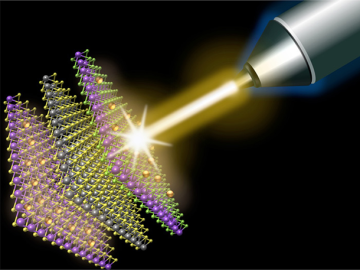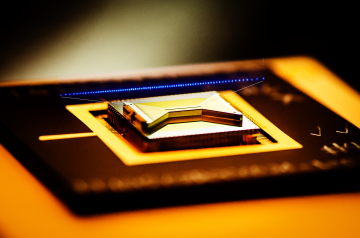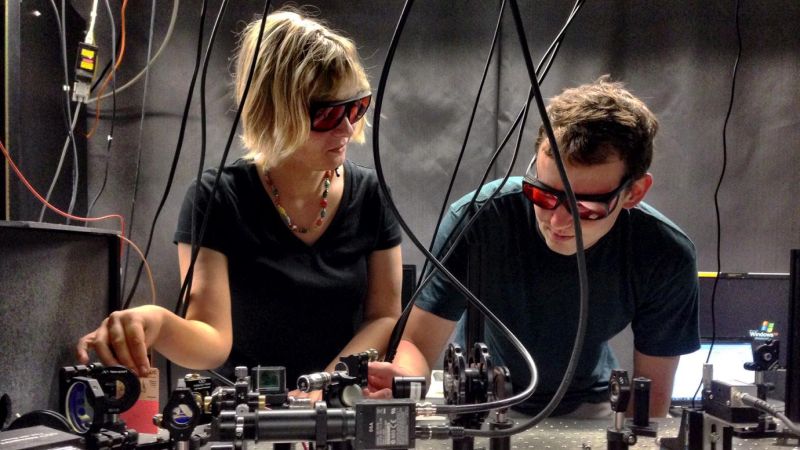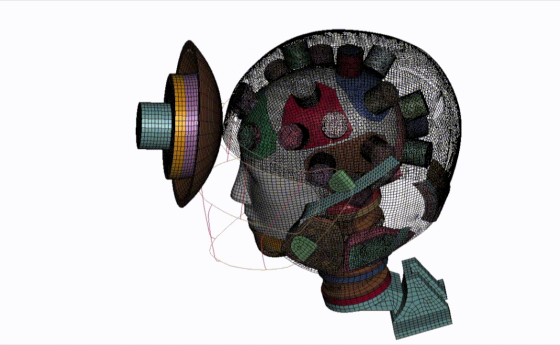
Bringing you the quantum future—faster
You’re going to live in a quantum future.
Sooner than we may once have imagined, new technologies will leverage quantum properties to create faster, more secure communications, powerful computers, sophisticated and compact sensors, and even new industrial materials. These developments, rooted in quantum discoveries, hold the potential to stimulate economic growth, strengthen national security, and improve the health and well-being of individuals around the world.
But just how distant is this future, and what will it take to get there?
The shift to a quantum world won’t happen overnight. The digital revolution began immediately after World War II, but it took several decades of fundamental discoveries and advances before digital technologies such as computers became commonplace in our homes and offices. Today, we are on the cusp of a similar revolution—one in quantum technologies. We can expect innovative applications of quantum principles to emerge at an accelerated pace over the next few decades.
Making the quantum future a reality is a goal that researchers around the globe have long been working toward. Quantum is still an emerging area of science, and building technologies that harness its potential will require extensive, fundamental research to better understand the principles that drive it. The U.S. also needs a significantly larger, quantum-educated science and engineering workforce ready to develop, operate and maintain the quantum technologies of the future.
For decades, the U.S. National Science Foundation has led strategic investments in foundational research and development that have jumpstarted the quantum revolution. Now NSF is working to address key scientific and technological challenges that must be overcome to unleash its full potential. In just the past month, NSF devoted $75 million to create new inter-disciplinary research institutes that address some of the most pressing topics in quantum information science and also invested $9.75M in awards to recruit quantum computing and information science faculty. Recently, NSF, with the White House Office of Science and Technology Policy, announced the National Q-12 Education Partnership, a groundbreaking plan to help young students become quantum learners.
At NSF, we’re working to bring you into that quantum future—faster.
What is quantum science?
Quantum physics is the study of matter and energy at its most basic level: the realm of tiny particles such as electrons and photons.
Photo Credit: Frank Ceballos, Physics and Astronomy Department, University of Kansas
Unlike some popular depictions in science fiction, quantum science won’t shrink you into an alien-fighting Antman or send you "quantum-leaping" through time to solve mysteries. While classical physics has given us a remarkable understanding of how the world works on large scales -- think Newton’s first law of motion … a body at rest stays at rest -- there are some things it can't explain at very small scales: the behavior of electromagnetic radiation, for example. That's where quantum theories come into play. They offer a fundamentally different way of understanding how particles and energy behave at very small scales.
The quantum future grows nearer, as scientists and researchers have begun to turn theories into technologies that leverage newly understood quantum properties. It's an abstract notion that is easier to understand when you consider a concrete example: the quantum computer. Researchers have been working to harness quantum principles by manipulating subatomic particles to do things such as store and process information in new and exciting ways.
While still in the early phases of development, quantum computers "think" and function very differently from your own computer. One day, they will do more than simply function as faster and better computers. But to do that, they need components that have never been built before, based on different principles from the ones that govern the transistors in your laptop.
Quantum computing is one area of the emerging field of quantum information science, or QIS, which also encompasses quantum communication, sensing, and more. QIS researchers have ambitious goals; and at every step of the way, they’re encountering new challenges that require resources and radical thinking to address.
Answering the big questions
QIS has the potential to fundamentally revolutionize society, but only after some overarching challenges are addressed.
Quantum computers are in development, but getting them to the point of commercial viability requires making them more reliable. Quantum computers utilize "qubits" as a basic unit of information storage processing. Creating a single qubit requires getting a particle into a state known as "superposition." This process is difficult, requiring highly specialized equipment, and it can be disrupted by something as simple as a loud noise in the room. Creating more stable systems is crucial because, as with any information system, a quantum computer has to be reliable to truly reach its potential.
That’s one challenge for quantum computers—but society needs more than just computers. It needs quantum networks. And every component that goes into those networks faces scientific questions just as difficult as those that face quantum computers. Software to control and program these quantum computers and networks is also critical to make the functionality of these systems accessible to innovators seeking to develop novel applications using these systems.
To help the research community reach its goals, NSF is tackling some of the big questions through its new Quantum Leap Challenge Institutes, three centers funded at $25 million each to make definitive, measurable progress in QIS. The institutes are the centerpiece of NSF’s Quantum Leap, an agency-wide effort to significantly advance research in QIS and quantum technology that has been underway since 2017. The institutes will represent the bulk of Quantum Leap investments through 2023.
Keeping qubits stable is a challenge, and the more qubits added to a single processor, the greater that challenge becomes. So one center, at the University of Illinois, Urbana-Champaign, is taking a different approach—exploring ways to build multiple quantum processors, each with a relatively small number of qubits, and connect them through quantum links. Systems like these could be optimized for different tasks such as making calculations or storing data, creating stronger, more versatile systems.
Another institute, at the University of Colorado, will explore the potential of quantum sensors able to measure everything from light to gravity's effects. This realm of study could bring us more precise data than any available today. Quantum sensors use quantum phenomena in their detections—that means they’re potentially more sensitive and more accurate than classical sensors. But we have yet to scratch the surface of their potential applications. The institute will design and build quantum sensors and make them available for use and testing.
The third center, at the University of California, Berkeley, is working to make sure that we're ready to use quantum computers once they become more viable. After all, what’s a computer without software? Researchers will develop quantum-computing algorithms optimized both for today's rudimentary computer prototypes and future, error-free quantum computers. One of their goals is to demonstrate that quantum computers can outperform even the top classical computers.
Building a quantum workforce
We are on the cusp of a new quantum revolution, and we need a well-trained workforce to accelerate it.
NSF has been funding quantum research and education since the 1980s, providing support for thousands of graduate students, post-docs, and early career researchers. Now NSF is going even further, finding ways to train students in the flexible thinking needed to learn about quantum and to adopt education concepts that could have broad benefits across the country.
NSF is investing $9.75 million into growing the academic faculty in quantum computer science and engineering, specifically within the computer science and computer engineering departments of 13 universities around the country. This cohort of Quantum Computing and Information Science Faculty Fellows will help advance the goal of easily programmable quantum systems and, more important, will teach and train multiple generations of undergraduate and graduate students in quantum-oriented problem solving.
Through the National Q-12 Education Partnership, NSF is investing $1 million in linking top industry and academic leaders to build a better-trained, more diverse group of quantum learners, ready one day to enter the quantum workforce.
This effort includes investing in projects such as a University of Illinois Urbana-Champaign and University of Chicago collaboration to create curricula and implement tools that will increase quantum awareness and literacy at the K-12 level -- and ultimately for all age groups. Organizers are now putting together web resources for educators and lining up education experts and industry partners to help shape the project and assess progress.
At the University of Texas, researchers are providing teachers with content and support while getting a sense of how students are learning QIS concepts. Another project, run by the American Association of Physics Teachers, will host summer workshops for teachers and build a community of educators working to deploy QIS-focused content at schools.
There are many more obstacles that we know about between us the quantum future -- and even more we don’t and will encounter along the way. But by identifying these roadblocks and giving researchers the resources they need to remove them, NSF is accelerating the quantum revolution.










